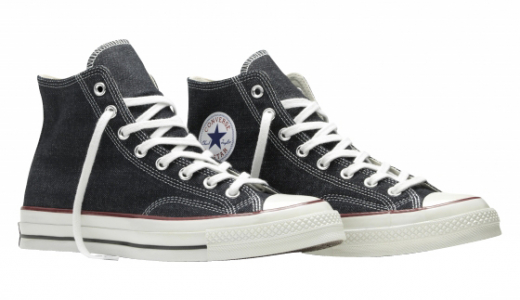Converse
Converse is an iconic American footwear brand renowned for its versatile and timeless designs, particularly its classic Chuck Taylor All Star sneakers. Founded in 1908 by Marquis Mills Converse, the company initially specialized in rubber shoes, but soon found its true calling through basketball. The Converse All Star basketball shoe, introduced in 1917, revolutionized the sport and cemented the brand’s place in sneaker history. The sneakers garnered significant popularity when Chuck Taylor, a basketball player turned Converse salesman and designer, lent his name and signature to the shoe, further enhancing its appeal. Over the years, the Chuck Taylor All Star has become a cultural staple, embraced by various subcultures, artists, and everyday people for its minimalist design and comfort. Its unmistakable silhouette—characterized by a canvas upper, rubber toe cap, and distinctive star-centered ankle patch—remains instantly recognizable and beloved worldwide.
Beyond its storied history in sports, Converse has also made significant inroads into fashion, music, and art. The sneakers have graced the feet of rock stars, skateboarders, and fashion icons, solidifying their status as a symbol of individualism and self-expression. Collaborations with high-fashion designers, artists, and other brands have kept Converse relevant and trendy, allowing the brand to innovate while maintaining its heritage. Aside from footwear, Converse has expanded its product range to include apparel and accessories, catering to a broader lifestyle market. Today, as part of the Nike, Inc. portfolio, Converse continues to innovate and captivate new generations with its unique blend of heritage and modernity, proving that a century-old brand can continually evolve while staying true to its roots.
History of Converse
The Genesis: Early 20th Century Beginnings
Converse's story begins in 1908, when Marquis Mills Converse founded the Converse Rubber Shoe Company in Malden, Massachusetts. Originally, the company specialized in the production of winterized rubber-soled footwear for men, women, and children. Initially, the firm’s market was smaller than other established footwear companies, but it managed to carve out a niche for itself due to its sturdy and reliable products.
The Birth of the Converse All-Star
The turning point for Converse came in 1917, when the company introduced its first basketball shoe, the Converse All-Star. This was a pivotal time in American sports culture, with basketball beginning to gain momentum as a popular athletic discipline. The Converse All-Star was designed with enhanced ankle support, providing athletes with better performance on the court. This innovation came ahead of its time, showing the company’s keen sense for blending functionality with the budding needs of sports athletes.
Chuck Taylor: A Star Is Born
The Converse All-Star shoe gained widespread popularity in the early 1920s, but it was the endorsement of a young basketball player named Chuck Taylor that catapulted the brand into national prominence. Taylor, an Indiana-born basketball player, joined Converse as a salesman and ambassador in 1921. He traveled across the United States promoting the shoes and conducting basketball clinics.
Taylor's behavioral acumen and understanding of the sport allowed him to contribute valuable feedback to the design of the All-Star shoe. His suggestions led to several improvements, including enhanced flexibility, better fit, and the addition of a patch to protect the ankle. In recognition of his contributions, the shoe was officially renamed the "Chuck Taylor All Star" in 1932 and featured his signature on the ankle patch. The "Chuck" would go down in history as one of the best-selling athletic footwear lines.
World War II: A Call to Serve
With the outbreak of World War II, Converse, like many American companies, redirected its manufacturing capabilities to support the war effort. The company produced footwear for the U.S. military, utilizing its expertise in creating durable and robust footwear. Converse made boots, parkas, and other essential gear for soldiers, proving the versatility and reliability of its manufacturing processes.
Post-War Boom: 1940s - 1960s
The post-war era was a time of significant growth and popularity for Converse. By the 1950s, the company's Chuck Taylor All-Star had become the dominant basketball shoe in America, worn by a majority of collegiate and professional players. The distinct high-top canvas design was both practical and emblematic of a burgeoning sports culture.
The Chuck Taylor shoe also crossed over from strictly athletic arenas to broader youth culture. In the 1960s, the shoe became emblematic of the counter-culture movement, worn by artists, musicians, and rebels as a symbol of rebellion and non-conformity. Rock stars like the Rolling Stones' Mick Jagger and The Ramones frequently sported Converse, making the brand synonymous with a certain rock 'n' roll ethos.
Competition and Decline: 1970s - 1980s
Despite its entrenched place in American culture, Converse began to face intense competition from new athletic brands like Nike, Adidas, and Puma in the 1970s and 1980s. These companies introduced more advanced shoe technologies, such as improved cushioning and arch support, which began to eclipse Converse's more traditional canvas and rubber designs.
While the Chuck Taylor remained popular for casual and fashion use, athletes began to opt for more technologically advanced footwear from competitors. Converse attempted to diversify its product line with various new designs and sponsorship deals with high-profile athletes and teams, but it struggled to regain its former dominance in the athletic shoe market.
Resilience and Rebranding: 1990s
By the early 1990s, Converse faced financial difficulties and declining market share. However, the brand's resilience shone through as it adapted to changing market dynamics. The company made efforts to recapture its former glory by sponsoring NBA stars such as Larry Johnson and Charles Barkley. These partnership deals brought a sense of renewed vigor to the brand, albeit not enough to completely revive its fortunes.
The brand also focused on its cultural roots. It capitalized on the nostalgic value of the Chuck Taylor All-Star shoe, leveraging its longstanding associations with music and counter-culture. New campaigns targeted younger demographics, particularly those involved in alternative music scenes such as punk rock, grunge, and indie rock.
The Fall and the Rescue: Late 1990s - Early 2000s
Despite these efforts, by 2001, Converse filed for bankruptcy. The company had become synonymous with its past, and despite attempts at modernizing, it failed to innovate in ways that kept up with athletic performance brands. However, the Converse story was far from over.
In 2003, Nike acquired Converse for approximately $305 million. The acquisition presented a whirlwind of opportunities and new strategies for revival. Under Nike’s stewardship, Converse wouldn't just survive – it would thrive.
The Nike Era: 2003 and Beyond
Nike's acquisition marked a significant turning point. Leveraging its marketing prowess, technological expertise, and global supply chain, Nike managed to turn around Converse's fortunes. The company focused on capitalizing on the strengths of the Chuck Taylor brand while introducing new styles and collaborations that bridged the gap between performance and lifestyle.
One of the key strategies was to re-establish Converse as a lifestyle and fashion brand rather than purely an athletic one. High-profile collaborations with designers, musicians, and artists led to limited-edition releases that re-energized the brand’s appeal. From collaborations with fashion icons like John Varvatos to partnerships with streetwear brands like Comme des Garçons, Converse found new ways to stay relevant and trendy.
Technological Innovations and Sustainability
Under Nike, Converse also embraced technological advancements to enhance its traditional designs. The introduction of the Chuck Taylor All-Star II in 2015 featured Nike’s Lunarlon cushioning, offering better comfort while retaining the classic aesthetic. Such innovations allowed Converse to marry its historic legacy with modern footwear technologies.
Additionally, the brand began emphasizing sustainability, aligning with Nike’s broader corporate commitment to environmental responsibility. Converse started using recycled materials for some of its products and focused on more sustainable manufacturing processes. These initiatives cemented Converse’s relevance in a market increasingly concerned with ethics and sustainability.
Global Icon Status
In the 2010s and 2020s, Converse transcended cultural and geographical boundaries. The brand's global appeal was a testament to its ability to continually reinvent itself. From urban fashion hubs in Tokyo and Paris to skater communities in Los Angeles and street artists in São Paulo, Converse managed to resonate with diverse demographics.
Pop culture also played a significant role. The rise of hip-hop culture saw Converse being adopted by various artists as part of their distinctive looks. Celebrities and influencers frequently showcased Chuck Taylors on social media, reinforcing their status as an enduring style statement. The shoe also appeared in numerous films, TV shows, and music videos, forever entwining it with modern cultural narratives.
Conclusion: A Legacy of Transformation
Converse's journey through the 20th and 21st centuries is a remarkable narrative of resilience, transformation, and cultural integration. Founded in 1908, the company swiftly moved from producing winterized footwear to creating one of the most iconic sneakers in basketball history. The Chuck Taylor All-Star, named after the sport’s first celebrity endorser, became a staple for athletes and a symbol of rebellion and style.
Despite facing intense competition and financial struggles, Converse's ability to adapt and reinvent itself ensured its survival. The acquisition by Nike in 2003 was a turning point, transforming Converse from a struggling brand to a global icon entrenched in both athletic and lifestyle markets. Today, Converse remains a testament to the power of innovation, collaboration, and cultural resonance, embodying a rich history that continues to inspire and evolve.























